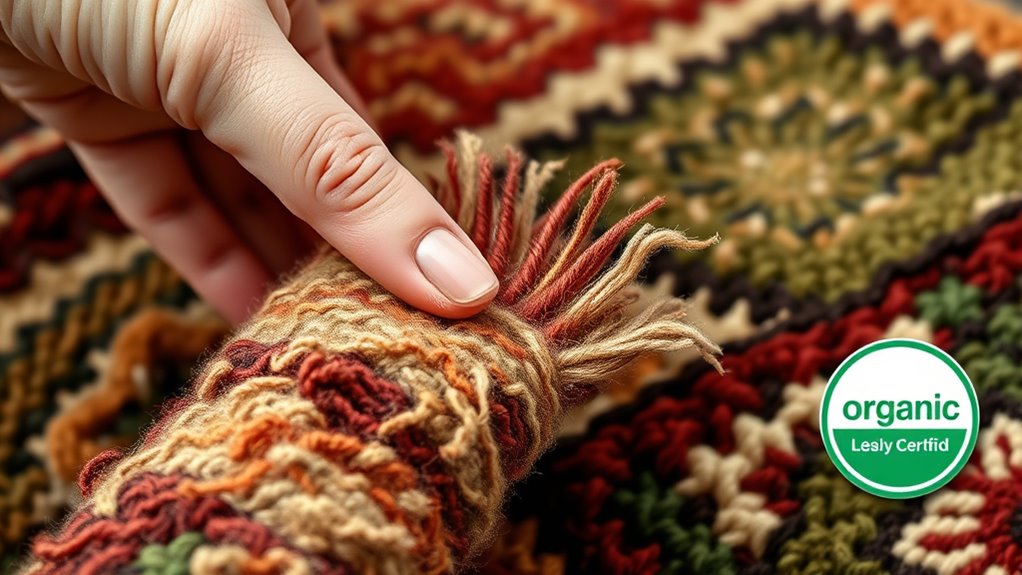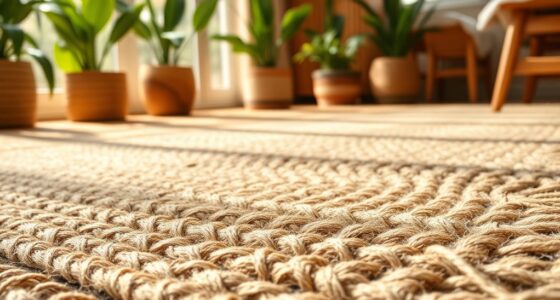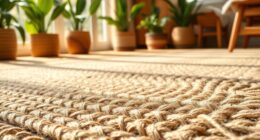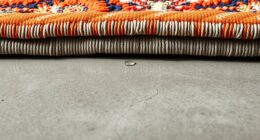Certified organic rug labels show they meet strict standards for eco-friendliness and safety, verified by organizations like GOTS or USDA. These labels confirm the fibers are grown without synthetic chemicals, and the manufacturing process avoids toxic dyes and treatments. Look for certification logos and ask for documentation to guarantee authenticity. If you want to understand what these labels truly mean and find genuine eco-friendly options, there’s more to uncover below.
Key Takeaways
- Certification labels like GOTS or USDA verify that rugs meet strict organic and environmental standards through inspections and documentation.
- Certified labels confirm natural fibers and dyes, ensuring no synthetic chemicals or toxic treatments are used.
- Vague claims like “eco-friendly” or “green” lack certification and do not guarantee organic or chemical-free materials.
- Certification processes involve on-site inspections, regular renewals, and strict compliance to maintain authenticity.
- Always look for official logos and request documentation to verify a rug’s organic certification status.
Understanding Organic Certification Standards
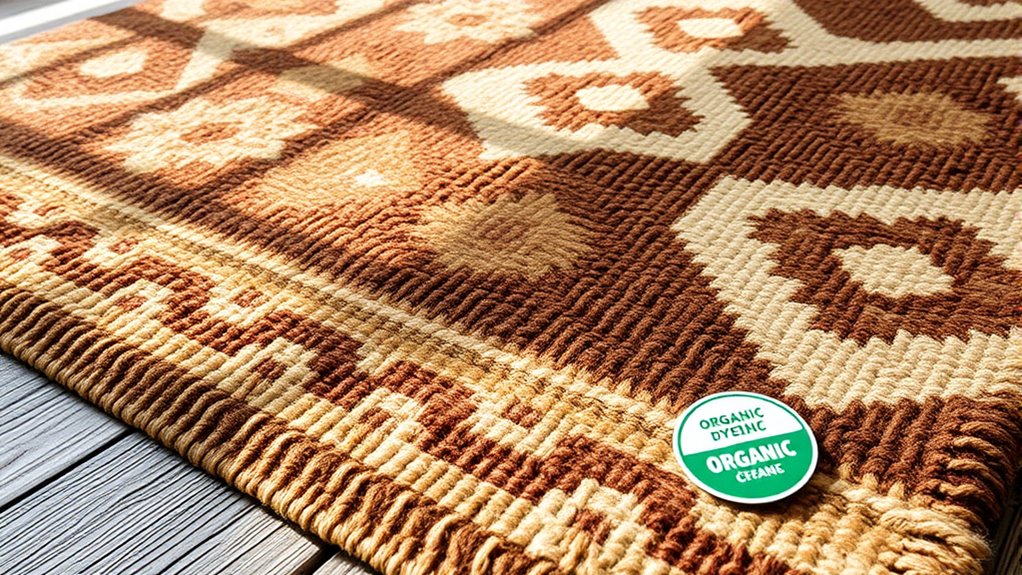
To guarantee a rug is truly organic, you need to understand the certification standards that verify its authenticity. These standards set clear guidelines for how the materials are grown, harvested, and processed, ensuring no harmful chemicals or synthetic dyes are used. Look for certifications from reputable organizations like GOTS (Global Organic Textile Standard), which require strict adherence to environmental and social criteria. Certification involves rigorous inspections, documentation, and ongoing compliance checks. When you see a recognized label, it confirms the rug meets high organic standards. Avoid vague claims or labels without certification, as they don’t guarantee authenticity. Knowing what to look for helps you make informed decisions and assure your rug aligns with your values of sustainability and health. Creative practice can also foster a greater appreciation for the craftsmanship behind authentic organic rugs.
Key Differences Between Organic and Conventional Rugs
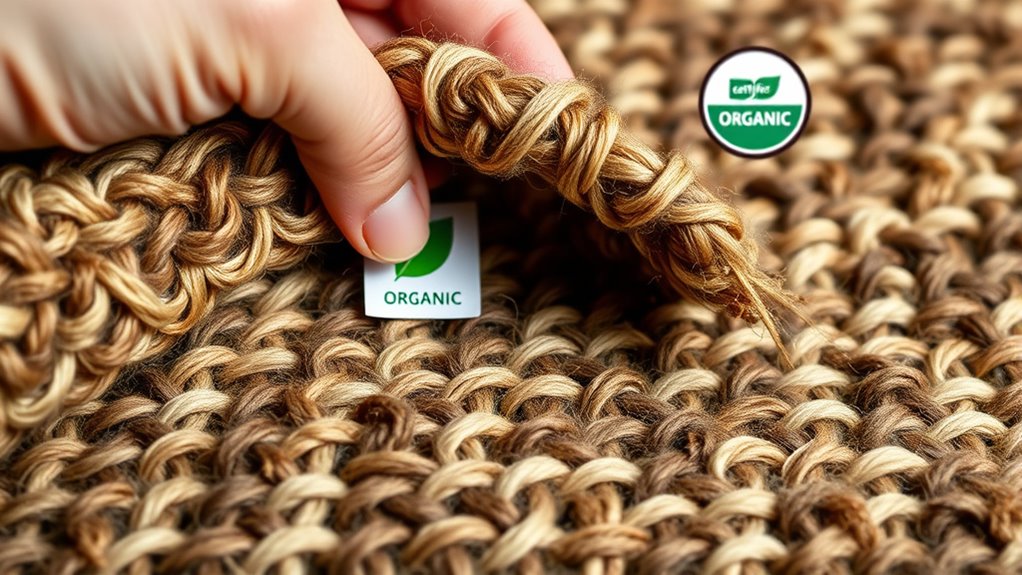
You’ll notice that organic rugs use sustainably sourced materials and avoid harmful chemicals, unlike conventional rugs. Chemical treatments in traditional rugs can affect indoor air quality, while organic options prioritize natural processes. Understanding these differences helps you choose rugs that are safer and more eco-friendly. Additionally, certifications and labels can provide assurance of a rug’s organic integrity and adherence to environmental standards.
Material Sourcing Practices
Have you ever wondered how organic rugs differ from conventional ones in their material sourcing? When it comes to organic rugs, the materials are carefully selected from farms that follow strict organic standards. You’ll find that fibers like wool, cotton, or jute are grown without synthetic fertilizers, pesticides, or genetically modified seeds. These materials are harvested sustainably, often with improved soil health and reduced environmental impact. In contrast, conventional rugs may come from sources that use chemical-intensive farming practices, which can affect the quality and safety of the fibers. Organic sourcing emphasizes transparency, ensuring that each fiber is traceable from farm to finished product. By choosing organic, you’re supporting environmentally friendly practices and reducing exposure to harmful chemicals often used in conventional material sourcing.
Chemical Treatment Variations
Chemical treatments play a significant role in distinguishing organic rugs from conventional ones. Conventional rugs often undergo chemical processes like flame retardants, stain repellents, and dyes containing synthetic dyes or toxic chemicals. These treatments enhance durability, stain resistance, and color vibrancy but can pose health risks and environmental concerns. In contrast, organic rugs avoid these synthetic chemicals, relying instead on natural dyes and treatments that are non-toxic and biodegradable. Organic standards restrict or prohibit the use of chemical finishes, ensuring the rug’s safety for your home and the environment. When shopping, look for labels that specify chemical-free or naturally treated products. This way, you’re choosing a rug that’s healthier for your family and better for the planet, aligning with eco-conscious and health-conscious values. Additionally, mammography guidelines emphasize the importance of choosing safer, non-toxic options for home products to reduce exposure to harmful chemicals.
Common Materials Used in Organic Rug Production
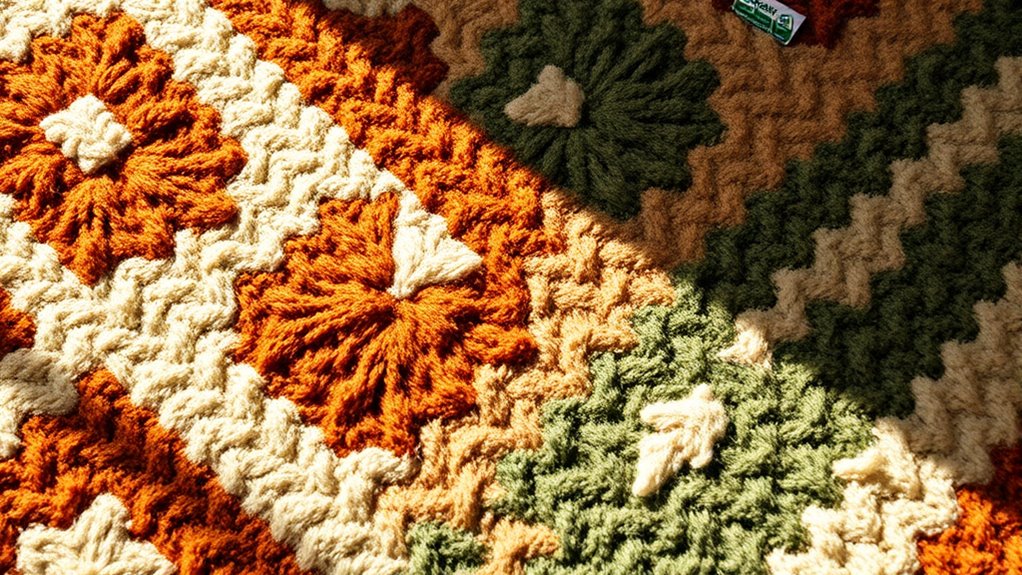
When choosing an organic rug, you’ll notice they’re made from natural fiber sources like wool, cotton, or jute, which are grown without synthetic chemicals. These materials are often paired with eco-friendly dyes derived from plants or minerals to guarantee the entire product remains sustainable. Understanding these materials helps you select rugs that are better for the environment and safer for your home. Additionally, knowledge of personal growth can guide you in making mindful decisions aligned with eco-conscious living.
Natural Fiber Sources
Natural fibers form the backbone of organic rug production, offering sustainable and eco-friendly alternatives to synthetic materials. You’ll find fibers like organic wool, cotton, jute, and sisal commonly used, each sourced from plants or animals raised without harmful chemicals. Organic wool comes from sheep fed on certified organic pasture, ensuring no synthetic pesticides or fertilizers are used. Cotton fibers are harvested from plants grown with organic farming practices, avoiding toxic pesticides. Jute and sisal are plant-based fibers grown without synthetic fertilizers, making them biodegradable and renewable. These natural fibers are durable, breathable, and biodegradable, making them ideal for eco-conscious consumers. Utilizing sustainable farming practices ensures the fibers are responsibly sourced and environmentally friendly. When selecting an organic rug, understanding these fiber sources helps guarantee you choose a product aligned with sustainable and environmentally friendly practices.
Eco-Friendly Dyes
Eco-friendly dyes play a essential role in ensuring that organic rugs remain truly sustainable. These dyes are derived from natural sources, reducing chemical pollution and supporting eco-conscious practices. When choosing an organic rug, look for dyes made from plant extracts, minerals, or other biodegradable materials. Here are three common materials used in eco-friendly dyes: Indigo – A natural dye from the indigo plant, known for its rich blue hue. Madder Root – Provides warm reds and oranges through sustainable harvesting. Turmeric – A bright yellow dye from turmeric rhizomes, offering vibrant color without chemicals. Additionally, the use of these dyes can help preserve natural dye sources and promote environmentally responsible manufacturing methods.
How to Read Organic Rug Labels and Certifications
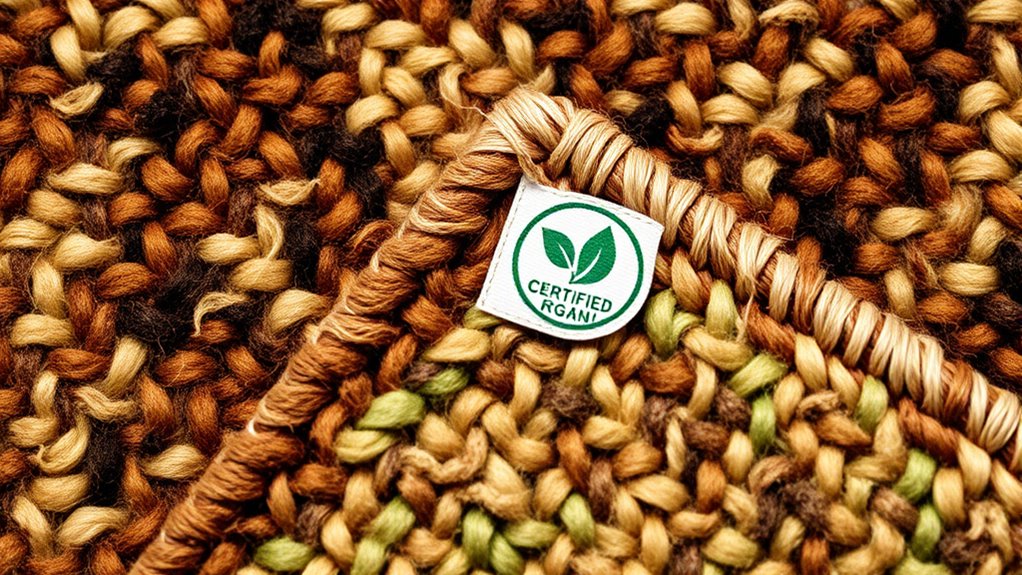
Understanding how to read organic rug labels and certifications is essential for making informed purchasing decisions. First, check for labels like “Certified Organic” or “GOTS” (Global Organic Textile Standard), which indicate third-party verification. Look for logos from reputable organizations, as these ensure the rug meets strict organic standards. Read the fine print for details about fiber content, dyes, and manufacturing practices. Certifications often specify the percentage of organic materials used, so higher percentages typically mean a more genuine product. Be wary of vague terms like “eco-friendly” or “natural,” which aren’t regulated. Confirm that the rug’s label explicitly states its organic credentials and certification body. Incorporating characteristics of creative geniuses, such as open-mindedness and persistence, can also help you approach your purchasing decisions with a more thoughtful and innovative mindset. This careful review helps you confidently choose rugs that align with your eco-conscious values.
The Certification Process for Organic Rugs
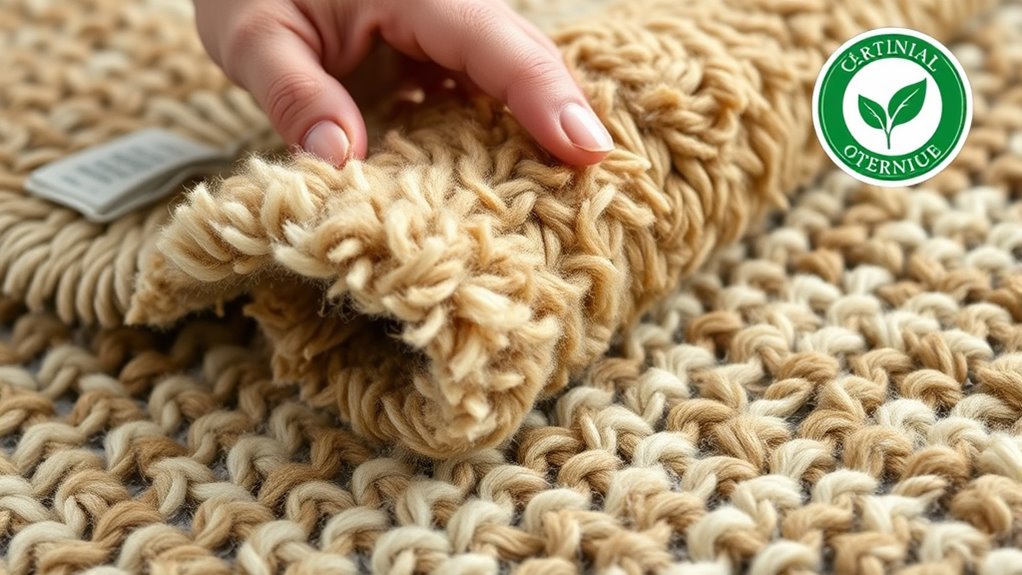
The certification process for organic rugs involves several steps to verify that the product meets established organic standards. First, you need to choose a certified organic rug from a reputable certifying body. Next, the manufacturer submits detailed documentation about their sourcing and production methods. Finally, an on-site audit is conducted to verify compliance with organic regulations. This process often includes evaluating the sourcing and production methods to ensure they align with organic standards. Here are the key steps:
- Application and documentation review
- On-site inspection of manufacturing facilities
- Certification issuance if standards are met
This process guarantees that the rug’s materials and production methods adhere to organic guidelines, giving you confidence in its authenticity. Keep in mind, certification must be renewed periodically to maintain trust in the product’s organic status.
Benefits of Choosing Certified Organic Rugs

Choosing certified organic rugs guarantees you’re getting a product that meets strict standards for safety and sustainability. These rugs are free from harmful chemicals, making them safer for your family and pets. They also support environmentally friendly practices, reducing pollution and conserving resources during production. By choosing organic, you promote healthier indoor air quality, as these rugs emit fewer volatile organic compounds (VOCs). Additionally, certified organic rugs often feature better durability and quality, ensuring they last longer and maintain their appearance. Supporting organic standards also encourages ethical farming practices, helping to protect ecosystems and promote fair labor conditions. Moreover, certifications ensure adherence to sustainable farming practices, which helps preserve biodiversity and soil health. Overall, opting for certified organic rugs aligns your home with eco-conscious values while providing a safe, stylish, and sustainable flooring choice.
Limitations and Challenges of Organic Certification
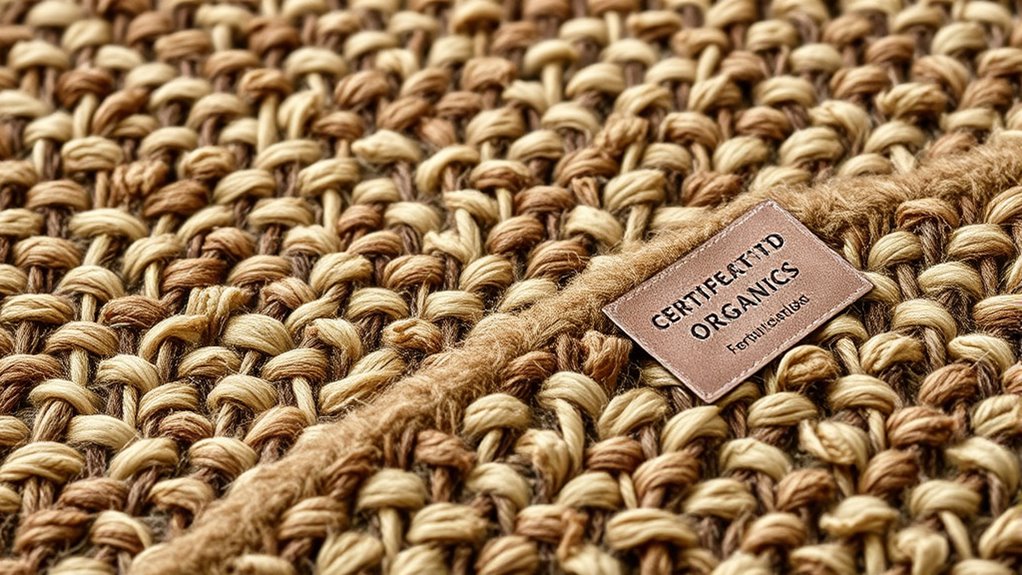
While certified organic rugs offer numerous benefits, there are notable limitations and challenges associated with obtaining and maintaining these labels. First, certification can be costly, making it difficult for small-scale artisans to afford the process. Second, the certification process is complex, requiring strict documentation and regular inspections that can be time-consuming. Third, organic standards can vary across certifying bodies, leading to inconsistencies and confusion for consumers. Additionally, some rugs may be partially organic or use organic materials in only certain parts, complicating the certification. These challenges can hinder your ability to verify authenticity and may limit the availability of truly certified organic rugs in the market. Ultimately, understanding these limitations helps you make more informed decisions when seeking certified organic products. Furthermore, the certification process often requires ongoing compliance and monitoring to ensure standards are maintained over time.
Tips for Verifying Organic Claims in the Market

Ever wondered how to confidently verify if a rug’s organic claim is genuine? Start by checking the label for recognizable certification logos from reputable organizations like GOTS or USDA Organic. Research the certifying body to ascertain it’s credible. Ask for documentation or certificates that prove the rug’s organic status; sellers should provide these upon request. Be wary of vague claims such as “eco-friendly” or “green,” which aren’t regulated. Conduct online research about the brand or retailer’s reputation and transparency. Trust your instincts—if something seems too good to be true, it probably is. Remember, genuine organic rugs often come with detailed information and official certification, so don’t hesitate to ask questions before making a purchase.
Sustainable Practices in Organic Rug Manufacturing

Sustainable practices in organic rug manufacturing focus on reducing environmental impact throughout the production process. You can support eco-friendly methods by looking for companies that prioritize responsible sourcing and waste reduction. Here are three key practices to watch for:
- Use of renewable energy sources — factories powered by solar or wind reduce carbon emissions.
- Eco-friendly dyes — natural or low-impact dyes minimize water pollution and toxic runoff.
- Waste management — recycling and composting scraps prevent excessive landfill waste.
Frequently Asked Questions
How Long Does an Organic Rug Certification Typically Last?
You wonder how long an organic rug certification lasts. Typically, it’s valid for one year, so you’ll need to renew it annually to guarantee your rug continues meeting organic standards. This renewal process often involves a review of your supplier’s practices and documentation. Staying on top of renewal dates guarantees your rug maintains its certified status, giving you confidence in its organic quality and sustainability.
Are Organic Rug Certifications Recognized Internationally?
You might wonder if organic rug certifications are recognized internationally. While some certifications, like GOTS, have global acceptance, others may only be valid in specific regions. It’s crucial to verify each certification’s recognition before purchasing. When you see a certified organic label, check its credibility and whether it’s accepted worldwide. This ensures you’re making an informed choice and investing in truly eco-friendly, globally recognized products.
What Are Common False Claims on Organic Rug Labels?
When shopping for organic rugs, you should watch out for false claims on labels. Some sellers might advertise rugs as “organic” or “natural” without proper certification. They may also exaggerate the eco-friendly aspects or claim the materials are entirely organic, which isn’t always true. Always verify the certification and ask for proof to guarantee you’re getting a genuinely organic product. Don’t be fooled by misleading labels or vague descriptions.
Can Organic Rugs Be Hypoallergenic or Allergen-Free?
Ever wondered if organic rugs are truly hypoallergenic? While they often use natural, chemical-free materials like wool or cotton, they aren’t guaranteed to be allergen-free. Organic rugs can reduce exposure to synthetic dyes and treatments that trigger allergies, but dust mites, mold, or pet dander can still cause reactions. So, if you’re sensitive, choose rugs with tightly woven fibers and consider a hypoallergenic lining for better allergy relief.
How Do Organic Rug Certifications Impact Pricing?
You might notice that organic rug certifications often lead to higher prices. That’s because certified rugs use premium, eco-friendly materials and undergo strict testing, which increases manufacturing costs. These certifications guarantee quality and sustainability, but they also mean you’re paying a bit more for these benefits. So, when you see a higher price, it’s a reflection of the added standards and ethical practices involved in producing certified organic rugs.
Conclusion
Choosing certified organic rugs is like planting seeds of change—each purchase nurtures a healthier planet and a more mindful future. By understanding labels and standards, you become a steward of sustainability, shaping a world where beauty and responsibility grow hand in hand. Remember, your choices are the roots that support a greener tomorrow; with each mindful step, you help cultivate a legacy of care, resilience, and hope.
